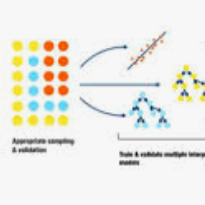Despite its great scientific and technological importance, wall-bounded turbulence is an unresolved problem that requires new perspectives to be tackled. One of the key strategies has been to study interactions among the coherent structures in the flow. Such interactions are explored in this study for the first time using an explainable deep-learning method. The instantaneous velocity field in a turbulent channel is used to predict the velocity field in time through a convolutional neural network. Based on the predicted flow, we assess the importance of each structure for this prediction using the game-theoretic algorithm of SHapley Additive exPlanations (SHAP). This work provides results in agreement with previous observations in the literature and extends them by quantifying the importance of the Reynolds-stress structures, finding a connection between these structures and the dynamics of the flow. The process, based on deep-learning explainability, has the potential to shed light on numerous fundamental phenomena of wall-bounded turbulence, including the objective definition of new types of flow structures.
翻译:尽管壁面湍流具有重要的科学和技术意义,但仍未解决,需要新的视角来解决。其中一个关键策略是研究流动中的相干结构之间的相互作用。本研究首次使用可解释的深度学习方法探讨了这些相互作用。通过卷积神经网络,利用湍流通道中的瞬时速度场预测时间中的速度场。基于预测的流场,我们使用SHapley Additive exPlanations (SHAP)的博弈论算法来评估每个结构对预测的重要性。本研究提供了与文献中先前观察结果一致的结果,并通过量化雷诺应力结构的重要性进一步扩展了它们,找到了这些结构和流动动力学之间的联系。本过程基于深度学习可解释性,具有揭示壁面湍流的许多基本现象的潜力,包括定义新的流动结构类型的客观定义。


